Tartan 3400
Intelligent design marks the evolution of the 34-foot Tartan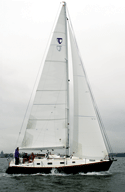
For years Tim Jackett, Tartan's chief designer, has done a commendable job of blending the proud Tartan pedigree with exciting new designs that embrace technology. The new 3400 is his latest example. Small touches like the wraparound cockpit coaming, and other more prominent features like the low-profile cabintop, are unmistakably Tartan. Thirty-four feet is sacred ground for Tartan, and the Fairport, Ohio-based company has a tough act to follow with the 3400. The first Tartan 34, known these days simply as the Tartan Classic, was designed by Sparkman & Stephens and launched in the 1960s. When combined with later 34 Mark II models built in the 1980s, nearly 1,000 Tartan 34s were built. While the 3400 salutes this storied past, it is not riding on its coattails. This exciting new boat is all about the future, the 3400 fairly lists with fresh thinking.
Jackett, who is also Tartan's chief operating officer, has created a performance-oriented, high-volume hull that is remarkably easy to handle. The sailplan includes a powerful full-batten main and a self-tacking 100-percent headsail. A furling reacher is rigged and ready to deploy the moment you fall off the wind. A carbon fiber mast and boom are standard. One day this won't seem out of the ordinary but for now there's no disputing the 3400 is ahead of its time. The epoxy hull construction is sophisticated, strong and light. I had the opportunity to test sail the 3400 recently and came away impressed. The boat lends new meaning to the phrase, intelligent design. The 3400 includes features generally reserved for the owners of big, incredibly expensive, semi-custom boats.
The details
 The Tartan 3400 hull is a composite of unidirectional E-glass, epoxy resin and CoreCell linear polyurethane coring. Through the use of resin impregnation machines, Tartan achieves a glass-to-resin ratio of 65 percent to 35 percent. The equation is simple: More glass and less resin equals strong, light hulls. The foam coring provides panel stiffness, sound and thermal insulation. The hull is vacuum-bagged to make sure there are no voids and then post-cured for 24 hours at 145 degrees, just to make sure the epoxy goes off. Pound for pound, an epoxy post-cured hull is dramatically stronger than a traditional hand-laid hull using more common polyester resins. The Tartan 3400 hull includes a 15-year structural and blister warranty.
The Tartan 3400 hull is a composite of unidirectional E-glass, epoxy resin and CoreCell linear polyurethane coring. Through the use of resin impregnation machines, Tartan achieves a glass-to-resin ratio of 65 percent to 35 percent. The equation is simple: More glass and less resin equals strong, light hulls. The foam coring provides panel stiffness, sound and thermal insulation. The hull is vacuum-bagged to make sure there are no voids and then post-cured for 24 hours at 145 degrees, just to make sure the epoxy goes off. Pound for pound, an epoxy post-cured hull is dramatically stronger than a traditional hand-laid hull using more common polyester resins. The Tartan 3400 hull includes a 15-year structural and blister warranty.
The 3400 deck is cored with Baltek AL 600 balsa. Core "windows" or areas of solid, reinforced laminate, are used wherever deck hardware is mounted. This technique limits core exposure and possible delamination down the road. Tartan does not through bolt deck hardware. Instead, stainless fasteners are drilled and tapped into aluminum plates in the deck. The obvious advantage is that hardware can be removed without the hassle of dealing with nuts and headliners below. When done well this method is perfectly adequate, especially on smaller boats. The hull-to-deck joint is the time-tested method of laying the deck on an inward facing hull flange. A T6 aluminum flat bar is molded in, forming a full sheer length backing plate.
The hull shape includes a clean entry that won't pound too much when sailing upwind in a blow. Full, flat aft sections create speed potential when sailing off the wind and cockpit and interior volume. Jackett has hit upon an ingenious concept with interchangeable keels.
"Innovative geometry in the attachment of the keel allows you to tailor-fit your 3400 to your sailing area," Jackett said.
Three keel configurations are offered. The bulbed fin, with a draft of 6 feet, 6 inches offers the best overall performance. An all-around 4-foot, 11-inch beavertail keel offers more moderate draft and the keel/centerboard option, a longtime Tartan trademark, is ideal for shoal-draft sailing. The board-up draft is just 4 feet. However, if you change your sailing area or just your attitude, you can order a different keel, have it shipped to the yard, and installed. This will become an alluring feature when Tartan 3400s hit the secondhand market. The rudder is made with high-density foam covered with epoxy skins. The stock is stainless steel and the rudder stuffing box is bronze, traditional and quality material choices that are well proven.
Jackett's plan was to create a genuinely fast boat that required minimal sail handling. These days it seems designers are searching for this Holy Grail in an attempt to lure new blood into sailing and to keep their plants working. Jackett hit the bullseye, the Tartan 3400 sails brilliantly and yes, it's a breeze to handle. With the 100-percent headsail unfurled tacking is simply a matter of turning the wheel. In theory, deploying the reacher is also a snap, unfortunately we didn't have this sail available for our test sail.
We had moderate conditions near Annapolis as we cleared Back Creek and hoisted sail. In 12 knots apparent we sped up to 6 knots on a tight reach. Sheeting in we sliced through the chop created by an armada of impatient powerboats. Designers and builders invariably claim that their hull shape won't pound in a seaway, and they're usually not telling the truth. The 3400 hull didn't pound, the motion was very soft, even upwind in a two- and three-foot chop, I was duly impressed. Easing off the wind we longed for the reacher, however with just the working sails we zoomed along at 6-plus knots.
On deck
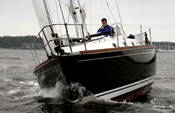 The 3400 is littered with Harken deck hardware, from winches to the traveler mounted forward of the companionway. Yes, it's time to mention the midboom sheeting dilemma again, but hey, I seem to be the only one left in the world who worries about boom loading so I am just going to drop it. Speaking of the boom, Jacket calls his carbon section a "trough." It's designed to help, with the aid of lazyjacks, to gather up the mainsail. When you're ready to tidy up you simply pull over the boom-stored sail cover and call it a day. Maybe it's just in my mind but I swear you can feel the difference a carbon fiber mast makes. The ride seems softer, quieter, there isn't as much pitching.
The 3400 is littered with Harken deck hardware, from winches to the traveler mounted forward of the companionway. Yes, it's time to mention the midboom sheeting dilemma again, but hey, I seem to be the only one left in the world who worries about boom loading so I am just going to drop it. Speaking of the boom, Jacket calls his carbon section a "trough." It's designed to help, with the aid of lazyjacks, to gather up the mainsail. When you're ready to tidy up you simply pull over the boom-stored sail cover and call it a day. Maybe it's just in my mind but I swear you can feel the difference a carbon fiber mast makes. The ride seems softer, quieter, there isn't as much pitching.
The 3400s mast is built by Novis Composites and is painted with white Awlgrip. The jib stay, which terminates just aft of the stem, is 7/8-rigged on the spar. The floating reacher luff is masthead rigged to really power things up off the wind. The 3400 has an air draft of 55 feet. Other numbers of interests? The ballast/displacement ratio is 34 percent, the sail area/displacement ratio is a respectable 18.8 and the displacement/length ratio is a fast 171.3.
Down below
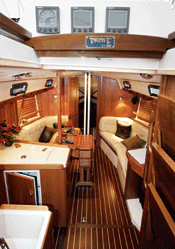 The interior is handsome and functional but not designed to be all things to all sailors. I like it. Finished in varnished cherry, the top-quality workmanship is obvious the moment you drop below. In keeping the overall ethos of the boat, structural bulkheads are bonded to hull and serious fiberglass timbers carry keel and mast loads. The plan includes a double cabin forward and another aft. A single head opposite the galley to starboard frees up space in both the forward cabin and saloon. The forward cabin is a bit tight, reflecting the fine entry, however the berth is a genuine double and there are two hanging lockers. The main cabin features opposing settees and a small drop-leaf table with a center storage bin and two drawers.
The interior is handsome and functional but not designed to be all things to all sailors. I like it. Finished in varnished cherry, the top-quality workmanship is obvious the moment you drop below. In keeping the overall ethos of the boat, structural bulkheads are bonded to hull and serious fiberglass timbers carry keel and mast loads. The plan includes a double cabin forward and another aft. A single head opposite the galley to starboard frees up space in both the forward cabin and saloon. The forward cabin is a bit tight, reflecting the fine entry, however the berth is a genuine double and there are two hanging lockers. The main cabin features opposing settees and a small drop-leaf table with a center storage bin and two drawers.
Jackett has employed slightly angled counters and half bulkheads to lend a sense of spaciousness below and there are well-placed teak handholds throughout. The galley includes a two-burner Force 10 cooker and a nine-inch molded Granicote single sink. There is storage in cherry faced lockers above the stove and below the sink. The well-insulated icebox is decent sized but refrigeration is optional. The navigation station is opposite the galley. It's easy to justify eliminating the nav station these days, especially in boats less than 40 feet, and I applaud Jackett for allotting space for what I still consider to be the most important spot below. The single head is good sized and includes a separate shower.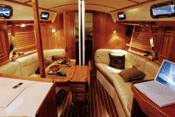 You realize the Tartan 3400 is just 34 feet by some of the specs and capacities. The freshwater tanks hold 60 gallons, not bad for a boat of this size but not enough for cruising without frequent stops. The two standard batteries are Group 27, these could be upgraded for more amps and oomph. Tartan has gone with corrosion-free Forespar Marelon valves both above and below the waterline. The 27-horsepower Yanmar diesel with a saildrive provides plenty of punch, is quite and extremely fuel efficient. The aluminum fuel tank holds 25 gallons and a single-lever control facilitates smooth handling under power. Engine access is excellent from behind the companionway and through side panels.
You realize the Tartan 3400 is just 34 feet by some of the specs and capacities. The freshwater tanks hold 60 gallons, not bad for a boat of this size but not enough for cruising without frequent stops. The two standard batteries are Group 27, these could be upgraded for more amps and oomph. Tartan has gone with corrosion-free Forespar Marelon valves both above and below the waterline. The 27-horsepower Yanmar diesel with a saildrive provides plenty of punch, is quite and extremely fuel efficient. The aluminum fuel tank holds 25 gallons and a single-lever control facilitates smooth handling under power. Engine access is excellent from behind the companionway and through side panels.
Under sail
 Back in the cockpit, we chased shifting breezes around the bay. The visibility from behind the 40-inch destroyer wheel is good and the sail controls are all led aft. An experienced sailor can singlehand the 3400. The cockpit seat backs are angled for comfort and the deep well will feel secure offshore. There is a good-sized locker to starboard, a dedicated propane locker and a sleek cutout for a swim step and telescoping ladder astern.
Back in the cockpit, we chased shifting breezes around the bay. The visibility from behind the 40-inch destroyer wheel is good and the sail controls are all led aft. An experienced sailor can singlehand the 3400. The cockpit seat backs are angled for comfort and the deep well will feel secure offshore. There is a good-sized locker to starboard, a dedicated propane locker and a sleek cutout for a swim step and telescoping ladder astern.
After tacking one more time we made our way toward Back Creek. We flopped the jib over, paid the main out and eased along wing and wing. Apparent winds fluctuated around 5 knots and our speed was about the same. I went forward. The side decks are wide and easy to navigate. The stainless stemhead fitting incorporates a single anchor roller. In fact, the stainless work is impressive, from the beefy 10-inch mooring cleats to the deck hatches, it seems like everything was shiny stainless steel. Well, not everything, the toerails and handrails were varnished teak. This is a Tartan after all.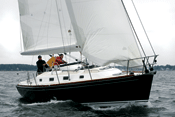
The Tartan 3400 is an exciting new model from one of America's premier builders. It combines thoughtful, high-tech construction, good performance and easy handling. It is also handsome and just feels right in the water. The 3400 extends Tartan's run of creating classic 34-footers.

Comments